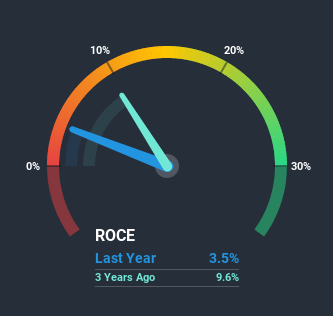Our Take On The Returns On Capital At Red Rock Resorts (NASDAQ:RRR)
What trends should we look for it we want to identify stocks that can multiply in value over the long term? Ideally, a business will show two trends; firstly a growing return on capital employed (ROCE) and secondly, an increasing amount of capital employed. Basically this means that a company has profitable initiatives that it can continue to reinvest in, which is a trait of a compounding machine. However, after investigating Red Rock Resorts (NASDAQ:RRR), we don't think it's current trends fit the mold of a multi-bagger.
What is Return On Capital Employed (ROCE)?
If you haven't worked with ROCE before, it measures the 'return' (pre-tax profit) a company generates from capital employed in its business. To calculate this metric for Red Rock Resorts, this is the formula:
Return on Capital Employed = Earnings Before Interest and Tax (EBIT) ÷ (Total Assets - Current Liabilities)
0.035 = US$125m ÷ (US$3.7b - US$200m) (Based on the trailing twelve months to December 2020).
So, Red Rock Resorts has an ROCE of 3.5%. On its own that's a low return on capital but it's in line with the industry's average returns of 3.9%.
Check out our latest analysis for Red Rock Resorts
In the above chart we have measured Red Rock Resorts' prior ROCE against its prior performance, but the future is arguably more important. If you're interested, you can view the analysts predictions in our free report on analyst forecasts for the company.
What The Trend Of ROCE Can Tell Us
On the surface, the trend of ROCE at Red Rock Resorts doesn't inspire confidence. To be more specific, ROCE has fallen from 11% over the last five years. Given the business is employing more capital while revenue has slipped, this is a bit concerning. If this were to continue, you might be looking at a company that is trying to reinvest for growth but is actually losing market share since sales haven't increased.
The Key Takeaway
In summary, we're somewhat concerned by Red Rock Resorts' diminishing returns on increasing amounts of capital. Investors must expect better things on the horizon though because the stock has risen 2.2% in the last three years. Regardless, we don't like the trends as they are and if they persist, we think you might find better investments elsewhere.
Red Rock Resorts does come with some risks though, we found 2 warning signs in our investment analysis, and 1 of those is a bit concerning...
While Red Rock Resorts may not currently earn the highest returns, we've compiled a list of companies that currently earn more than 25% return on equity. Check out this free list here.
This article by Simply Wall St is general in nature. It does not constitute a recommendation to buy or sell any stock, and does not take account of your objectives, or your financial situation. We aim to bring you long-term focused analysis driven by fundamental data. Note that our analysis may not factor in the latest price-sensitive company announcements or qualitative material. Simply Wall St has no position in any stocks mentioned.
Have feedback on this article? Concerned about the content? Get in touch with us directly. Alternatively, email editorial-team (at) simplywallst.com.

